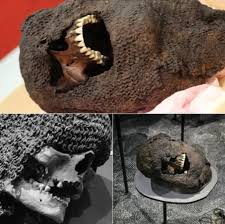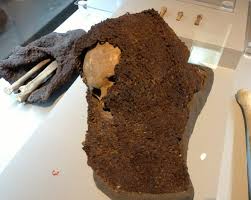Medieval Warrior Skull with Chainmail: A Silent Witness from the Battle of Visby (1361)

Medieval Warrior Skull with Chainmail: A Silent Witness from the Battle of Visby (1361)
Unearthed from the cold soil of Gotland, Sweden, the skull of a fallen warrior lies still — hollow eyes forever fixed in the silence of death, yet speaking volumes of a brutal past. Draped in a rusted chainmail coif that once offered protection in the heat of battle, this haunting relic emerged from a mass grave outside the walls of Visby, a site that bears witness to one of the most harrowing episodes in Scandinavian medieval history.
The year was 1361. The island of Gotland, prosperous and strategically important in the Baltic Sea, found itself under siege by King Valdemar IV of Denmark. As the Danish forces landed on its shores, the local defenders — largely made up of peasants and townsfolk, hastily conscripted and ill-equipped — rose to defend their homeland. Lacking proper armor and training, they nonetheless stood against a professional, battle-hardened army.

The confrontation culminated in the infamous Battle of Visby, fought just outside the city walls in the sweltering summer heat. What followed was a massacre. Nearly 1,800 defenders were slaughtered in a single day. Many died in their tracks, their bodies later tossed into hastily dug mass graves. Some still wore what little armor they could afford or scavenge — padded tunics, mismatched gear, or, in rare cases like this one, a chainmail coif.
The skull, now weathered by centuries underground, retains the tragic dignity of the man it once was. The mail hauberk, corroded and brittle, clings tightly to the cranium — a final testament to the brutal melee he likely endured before falling. Perhaps he was struck down by a Danish axe, a spear, or the crushing blow of a sword. Whatever his fate, he died defending his home, surrounded by comrades equally unprepared for the slaughter that awaited them.

For historians and archaeologists, this warrior’s remains are more than just a grim curiosity — they are a rare and poignant bridge to the human stories beneath the statistics of war. The mass graves at Visby, unusually well-preserved, provide an unparalleled glimpse into the reality of medieval combat and the desperate valor of common men forced into extraordinary circumstances.
Today, this skull stands not only as a relic of violence and conquest but also as a symbol of sacrifice and the enduring cost of war. In its silent stillness, it reminds us that history is written not only in chronicles and royal edicts, but in the bones of those who had no voice — only duty, fear, and courage.
Thank you !